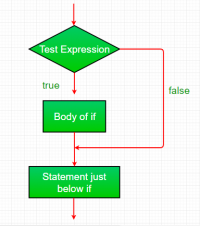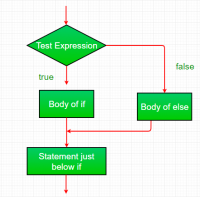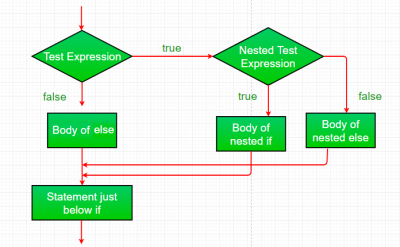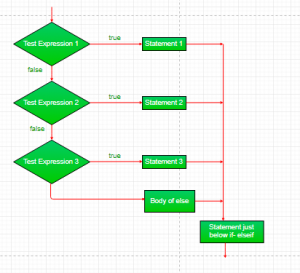JAVA: Pengambilan Keputusan di Java
Proses pengambilan keputusan dalam pemrograman mirip dengan pengambilan keputusan dalam kehidupan nyata. Dalam pemrograman juga menghadapi beberapa situasi di mana kita ingin blok code tertentu dieksekusi ketika beberapa kondisi terpenuhi.
Sebuah bahasa pemrograman menggunakan pernyataan kontrol untuk mengontrol aliran eksekusi program berdasarkan kondisi tertentu. Ini digunakan untuk menyebabkan aliran eksekusi berjalan / maju dan bercabang berdasarkan perubahan status program.
Perintah untuk melakukan pemilihan di Java:
- if
- if-else
- nested-if
- if-else-if
- switch-case
- jump – break, continue, return
1. if:
Pernyataan if adalah pernyataan pengambilan keputusan yang paling sederhana. Ini digunakan untuk memutuskan apakah pernyataan atau blok pernyataan tertentu akan dieksekusi atau tidak, yaitu jika kondisi tertentu benar maka blok pernyataan akan dieksekusi jika tidak.
Syntax:
if(condition)
{
// Statements to execute if
// condition is true
}
Di sini, kondisi setelah di evaluasi akan benar atau salah. jika pernyataan menerima nilai boolean - jika nilainya benar maka akan mengeksekusi blok perintah di bawahnya.
Jika kita tidak memberikan kurung kurawal '{' dan '}' setelah if( condition ) maka secara default pernyataan if akan menganggap pernyataan langsung berada di dalam bloknya. Sebagai contoh,
if(condition) statement1; statement2; // Here if the condition is true, if block // will consider only statement1 to be inside // its block.
Contoh:
// Java program to illustrate If statement
class IfDemo {
public static void main(String args[])
{
int i = 10;
if (i > 15)
System.out.println("10 is less than 15");
// This statement will be executed
// as if considers one statement by default
System.out.println("I am Not in if");
}
}
Output
I am Not in if
2. if-else:
Pernyataan if sendiri memberi tahu kita bahwa jika suatu kondisi benar, itu akan mengeksekusi blok perintah dan jika kondisinya salah, blok tersebut tidak akan dilakukan. Tetapi bagaimana jika kita ingin melakukan sesuatu yang lain jika kondisinya salah. Di sinilah pernyataan lain. Kita dapat menggunakan pernyataan else dengan pernyataan if untuk mengeksekusi blok code ketika kondisinya salah.
Syntax:
if (condition)
{
// Executes this block if
// condition is true
}
else
{
// Executes this block if
// condition is false
}
Contoh:
// Java program to illustrate if-else statement
class IfElseDemo {
public static void main(String args[])
{
int i = 10;
if (i < 15)
System.out.println("i is smaller than 15");
else
System.out.println("i is greater than 15");
}
}
Output
i is smaller than 15
3. nested-if:
Sebuah nested if adalah pernyataan if yang merupakan target dari if atau else lainnya. Pernyataan nested if berarti pernyataan if di dalam pernyataan if. Ya, java memungkinkan kita untuk membuat pernyataan if di dalam pernyataan if. yaitu, kita dapat menempatkan pernyataan if di dalam pernyataan if yang lain.
Syntax:
if (condition1)
{
// Executes when condition1 is true
if (condition2)
{
// Executes when condition2 is true
}
}
Contoh:
// Java program to illustrate nested-if statement
class NestedIfDemo {
public static void main(String args[])
{
int i = 10;
if (i == 10) {
// First if statement
if (i < 15)
System.out.println("i is smaller than 15");
// Nested - if statement
// Will only be executed if statement above
// it is true
if (i < 12)
System.out.println(
"i is smaller than 12 too");
else
System.out.println("i is greater than 15");
}
}
}
Output
i is smaller than 15 i is smaller than 12 too
4. if-else-if ladder:
Di sini, pengguna dapat memutuskan di antara beberapa opsi. Pernyataan if dieksekusi dari atas ke bawah. Segera setelah salah satu kondisi yang mengendalikan if benar, pernyataan yang terkait dengan itu jika dieksekusi, dan sisa perintah-perintah di bawahnya akan dilewati. Jika tidak ada kondisi yang benar, maka pernyataan else terakhir akan dieksekusi.
if (condition)
statement;
else if (condition)
statement;
.
.
else
statement;
Contoh:
// Java program to illustrate if-else-if ladder
class ifelseifDemo {
public static void main(String args[])
{
int i = 20;
if (i == 10)
System.out.println("i is 10");
else if (i == 15)
System.out.println("i is 15");
else if (i == 20)
System.out.println("i is 20");
else
System.out.println("i is not present");
}
}
Output
i is 20
5. switch-case:
The switch statement is a multiway branch statement. It provides an easy way to dispatch execution to different parts of code based on the value of the expression.
Syntax:
switch (expression)
{
case value1:
statement1;
break;
case value2:
statement2;
break;
.
.
case valueN:
statementN;
break;
default:
statementDefault;
}
The expression can be of type byte, short, int char, or an enumeration. Beginning with JDK7, expression can also be of type String. Duplicate case values are not allowed. The default statement is optional. The break statement is used inside the switch to terminate a statement sequence. The break statement is optional. If omitted, execution will continue on into the next case.
6. jump:
Java supports three jump statements: break, continue and return. These three statements transfer control to another part of the program.
Break: In Java, a break is majorly used for: Terminate a sequence in a switch statement (discussed above). To exit a loop. Used as a “civilized” form of goto. Continue: Sometimes it is useful to force an early iteration of a loop. That is, you might want to continue running the loop but stop processing the remainder of the code in its body for this particular iteration. This is, in effect, a goto just past the body of the loop, to the loop’s end. The continue statement performs such an action.
continue-in-java
Example:
// Java program to illustrate using
// continue in an if statement
class ContinueDemo {
public static void main(String args[])
{
for (int i = 0; i < 10; i++) {
// If the number is even
// skip and continue
if (i % 2 == 0)
continue;
// If number is odd, print it
System.out.print(i + " ");
}
}
}
Output
1 3 5 7 9
Return: The return statement is used to explicitly return from a method. That is, it causes program control to transfer back to the caller of the method.
Contoh:
// Java program to illustrate using return
class Return {
public static void main(String args[])
{
boolean t = true;
System.out.println("Before the return.");
if (t)
return;
// Compiler will bypass every statement
// after return
System.out.println("This won't execute.");
}
}
Output
Before the return.



